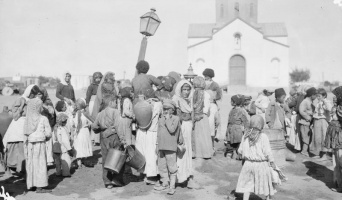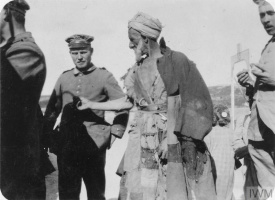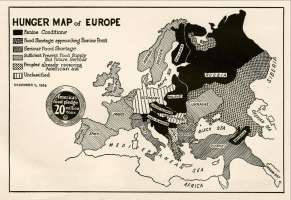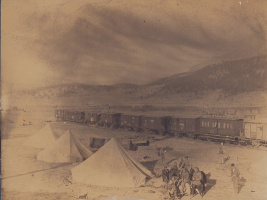Introduction↑
An Ottoman administrator, Mehmet Celal Bey (1863-1926), noted in 1917 that the Ottoman Empire was unable to compete, “in the battles of this world,” in the absence of reliable economic statistics: “We are as he who gathers firewood in the dark.” (fa nahnu kā khātib al-layl).”[1] Celal, Minister of Forests and Agriculture in Mount Lebanon, based his observation on three years of experience watching the Ottoman war effort struggle to cope with the pressures of industrial warfare. The WWI Ottoman economy presents the historian with the same difficulty confronted by the wartime administration in Istanbul: the opaque and pre-industrial attributes that hampered Ottoman mobilization for war also prevent systematic economic analysis in retrospect. In 1914, the Ottoman economy lacked the cohesion necessary for effective central planning to rival its adversaries. In consequence, the substantial quantitative information that underpins studies of Germany’s wartime economy does not exist for the Ottoman case. Nonetheless, the basic facts of the performance of the Ottoman economy during the war remain as clear to historians as they were to contemporaries such as Celal: the Ottoman regime’s schemes for offensive warfare against the Russian Empire and British Egypt surpassed the Empire’s economic capabilities and the resulting overstretch led to its collapse.
The Empire’s economy was capable of adequately supporting the defense of its territory against three years of British, French, and Russian onslaught, but could not support offensives against those same powers, or sustain the Empire’s defense through 1918. Not only was it insufficiently equipped for the “battles of this world,” but the Ottoman economy could not even be relied upon to provide the basic grain requirements of its inhabitants. Famine spread amongst civilian populations beginning in the spring of 1915. By the war’s end in October 1918, significant portions of the Ottoman population, including soldiers, were dead or dying from hunger.
In terms of the final outcome, the Ottoman experience did not differ greatly from that of the Central Powers: they lacked the resources to compete with the British and French war machine. Although scarcity hobbled the Ottoman economy more quickly than its allies, Germany too suffered from a lack of resources, surrendering when it could no longer provide sufficient food rations to its population.[2] Economics determined the ultimate outcome of the war,[3] and the defeat of the Ottoman Empire along with its allies. Based on the prolonged nature of the conflict, “resources counted for almost everything. The greater Allied capacity for taking risks, absorbing the cost of mistakes, replacing losses, and accumulating overwhelming quantitative superiority eventually turned the balance against Germany,”[4] as well as the Ottoman Empire. The Entente pressed this “quantitative superiority” through its blockade, which suffocated its adversaries’ importation of critical foodstuffs. A couple of years before scarcity tore Germany and Austria-Hungary’s war effort asunder, the Ottoman Empire had begun suffering famines and epidemics linked to extreme resource scarcity.
Poor Planning?↑
Much has been made of the exceptional nature of the Ottoman state among European powers: for three generations of European diplomats, the Ottoman Empire was a “sick man,” its existence more precarious than any other European state. Historians recycled this characterization at some length to suggest the inevitability of Ottoman collapse. Contrary to its depiction as exceptional, the mobilization of the Ottoman economy for war in 1914 quite resembled the initial stages of other powers’ economic preparations. Namely, the novel scale of coordination meant that as in Britain, France, the Austro-Hungarian Empire and Germany, chaos reigned as preparations for total war required mobilization of maximum resources. “Total” resource mobilization was always more aspirational than real but the government intended, at every turn, to subordinate each aspect of the economy to wartime needs. If not exceptional, the Ottoman economy’s capacity to mobilize for protracted industrial warfare paled in comparison to that of its allies and adversaries. Its undercapitalized aspect, along with a low level of industrialization in manufacturing and agriculture, ensured much difficulty for the mobilization of the Ottoman war machine. Historians, such as David Fromkin, have erroneously assumed that poor planning, and not a lack of industrial capacity, led to Ottoman military failures:
Fromkin’s critique of Ottoman policy appears to assume that the length of the war was an obvious fact to Europeans. Yet, politicians in London, Paris, Berlin and Vienna were equally unaware that the war would involve a series of protracted campaigns over several years. Their economic planning met similarly steep challenges. No power foresaw the extent of economic preparations that would be necessary to gird their society for a prolonged war; the leadership of each respective country, as Fromkin erroneously suggests, cannot be seen to have decided the success or failure of the conflict.
Contrasts between the Ottoman experience and that of the other major belligerents are as revealing as the similarities. The Ottoman Empire’s vulnerabilities were, in hindsight, numerous. The presence of a large peasantry represented a stark disadvantage for the Ottoman economic mobilization.[6] Even more than Austria-Hungary and Russia, this agricultural orientation of its economy made it the least prepared to mobilize its society for total war. Despite the limitations of the empire’s economy, the Ottoman leadership embarked on multi-front military campaigns believing that only through offensive action could they avenge the territorial losses suffered at the hands of the Russian and British Empires.[7]
Despite all the weaknesses in the Ottoman economy’s ability to mobilize resources for war, it proved adept at fighting defensive battles. At Gallipoli, most famously, but also in Iraq and Gaza, the Ottoman army held its ground against better-equipped British and French forces. Their successes in defensive warfare suggest the opposing view that, had the Empire stuck to defending its borders, it could well have survived the war.
Finance and Industrial Production↑
The Ottoman Empire’s factories and financial institutions, crucial implements of war making during WWI, were plainly deficient. The Committee of Union and Progress (CUP) entered the war with “its state treasury virtually empty.”[8] Cash injections from Germany ultimately sustained the Ottoman war effort. During the initial Ottoman offensives against the Caucasus Mountains and the Suez Canal in 1914 and early 1915, the government could not afford to pay its troops, severely damaging morale. That situation alarmed German military advisors who convinced their government to begin transferring hundreds of millions of marks to their Ottoman allies to prevent (what would have been) the catastrophic loss of the Dardanelles.[9]
In addition to its financial woes, unfavorable treaties with Western powers had limited the Ottoman state’s ability to industrialize. At the outbreak of war, the Ottoman military effort could only rely on “a single cannon and small arms foundry, a single shell and bullet factory, and a single gunpowder factory,” all located in the environs of Constantinople.[10] War materiel would have to be imported from Germany for the duration of the conflict.[11] The Ottoman Empire could only count on fewer than sixty enterprises with more than 100 employees and only 600 with more than ten workers.[12] The import of manufactured goods, stipulated by treaties with European powers, had undermined artisanal production and left the Empire dependent on trade. In light of the abrogation of trade agreements with Entente powers and the blockade, the war saw a small but significant expansion of industrial production for building materials, foodstuffs and textiles.[13] The financial and industrial capabilities of the Ottoman Empire, indigenous and borrowed from their German allies, were only sufficient to provide for the Empire’s defense.
Production was concentrated around the capital, aiding the defense of nearby Gallipoli in 1915. Constantinople hosted the majority of industrial establishments in the Ottoman Empire (55 percent)[14] and could draw foodstuffs imported from Anatolia on the Baghdad Railway. In the conflict that followed WWI—the Turkish War of Independence—nationalist forces proved adept at Anatolia’s defense, despite having lost their capital city, along with most of the country’s factories and its treasury.
Transportation and Coal↑
Some years before the war, the British Admiralty hatched a plan to blockade Germany in the event of a war, realizing their potential adversary’s vulnerability as a net importer of grain. The Ottoman Empire was even more susceptible to blockade, as the war would prove, in its heavy reliance on the Mediterranean to link its internal markets. Railways in the Ottoman Empire generally connected agricultural hinterlands with coastal ports. For instance, the Adana plain relied on rail connections with the port at Mersin, from where cotton, wheat and other commodities found markets via the Mediterranean. At the beginning of the war, no railway connected the empire’s Anatolian and Syrian provinces. Shipments to Syria had to be unloaded, carried over mountain passes, and then reloaded.[15] Intended to interface with maritime transport and not to foster internal mobility, the Ottoman railway system became impotent in the face of the Entente blockade that stopped maritime traffic.[16]
Difficulties moving men and materiel stymied the Ottoman offensive capabilities. The Empire could rely on 5,759 kilometers of railways in 1914, substantially less than any other belligerent in the war.[17] Wartime resource deficits undermined the ability to use what small rail network the Ottomans did have: coal production plummeted during the war, dropping 40 percent by 1916 and a full 75 percent by 1918.[18] No railway could supply the eastern front against Russia, however, as the Czarist government had successfully prevented its construction through diplomatic pressure. Russia’s pre-war scheme to prevent rail links to the Empire’s eastern provinces paid handsome dividends when Ismail Enver Pasha’s (1881-1922) campaign against Russia foundered amidst the failure of Ottoman supply lines. The railways connecting Constantinople with Ahmed Cemal Paşa’s (1872-1922) armies attacking Suez were incomplete. In part because of these transportation difficulties, Enver Pasha and Cemal Paşa’s offensives met with disastrous failure.
Agricultural Production and Foodstuffs↑
The Ottoman Empire struggled to maintain prewar levels of agricultural production in large part because its agricultural sector had generally not been mechanized. As Şevket Pamuk has noted, this left it inflexible in dealing with the rapid disappearance of men from the Empire’s agricultural fields. In countries with mechanized capabilities, machines could replace men and output need not suffer. The Ottoman Empire conscripted widely among the peasant masses: no other input could be substituted for their labor. This lack of flexibility hampered Ottoman food production amidst the reality of scarce labor in the countryside.[19] Military requisitioning of draft animals hampered the ability of farmers to plow and fertilize the land. Meanwhile, the likelihood that the army would seize grain in excess of a producer’s subsistence needs convinced many to sow less. Lastly, the government’s introduction of paper money, with uncertain value, created additional chaos in the agricultural economy by limiting the regime’s ability to purchase foodstuffs.
Ottoman officials outsourced the provisioning of foodstuffs to consortia of merchants, lacking the administrative capacity to enact an empire-wide system of grain distribution. In Anatolia, this policy aimed at rewarding Muslim merchants loyal to the CUP ruling clique. In Lebanon and Syria, an intersect commercial/state alliance saw Ottoman officials and Christian and Muslim merchants entrusted with ensuring the civilian population was well supplied with food. Limited shortfalls in grain harvests morphed into a catastrophic decline in the market release of wheat. Those charged with feeding civilian populations with grain in Syrian and the Lebanon sought profits instead of the public good.[20] Their criminal negligence wrought terrible consequences and in the hardest hit areas, such as Lebanon, one in three inhabitants starved to death. The war ended with much of the Empire’s population suffering from hunger. Food shortages also sapped the morale and fighting capabilities of the Ottoman military.
The Economic Consequences of the Genocide↑
Alone among the belligerents, the Young Turk administration attempted a scheme of large-scale social engineering during the war despite being the least equipped of the warring parties to do so. If the Ottoman Armenian policy intended to secure some immediate or future “security” for Anatolia, the short-term economic consequences of the expulsion hindered the government’s ability to optimize the functioning of its war economy. The sheer transportation requirements of deporting more than one million Armenians strained the capacity of Ottoman roads and railways during a critical period of mobilization for war. Their removal from key industries also hampered production: Armenians represented nearly 10 percent of Anatolia’s population, and a disproportionately large percentage of skilled laborers.
Expulsions were destined to create lethal circumstances for the deportees and little was done to treat the epidemics of typhus that raged in their caravans and concentration camps. Ottoman authorities do not appear to have fully considered the public health implications of the deportations. Only a few months after the 24 April 1915 deportation order, Ottoman telegrams reveal that the waves of Armenian deportees had come to represent a severe threat to public health in the eyes of the highest ranks of the military. In July, Cemal Pasha complained about the corpses of dead Armenians floating down the Euphrates that he assumed to be coming from Dr. Mehmed Reşid’s (1873-1919) jurisdiction in Diyarbekir. Mehmed Talat Pasha (1874-1921) also admonished Reşid for leaving the corpses of Armenians in the open.[21] The presence of unburied corpses was only one way that the genocide threatened the health of the Ottoman population. Cemal warned Talat’s Interior Ministry in October 1915 that epidemic disease outbreaks among the Armenian deportees would likely jump to his Fourth Army.[22] Their complaints reveal that collateral ecological damage of the genocide was threatening the Ottoman war effort as disease spread to non-Armenian military and civilian populations.
At a time when the Ottoman government desperately needed to maximize its economic resources, its decision to deport the Armenians had the opposite effect by undermining its labor force and disrupting its limited transportation networks. The genocide’s contribution to epidemic disease meant that sick troops and civilians could not contribute to the war effort. Conversely, the seizure of Armenian wealth and property aided the Ottoman war effort in some regard. Empty Armenian homes helped the Ottoman regime address the homelessness of Muslim refugees from the Balkans while enriching a new class of Muslim bourgeoisie and providing for the needs of the army, state, and militia organizations.[23] Without quantitative data, it would be impossible to fully gauge the economic impact of the genocide. Nevertheless, the deportation of Armenians appears to have hindered the Ottoman war effort at a crucial juncture in the war.
Conclusion: Economic Legacy↑
Turkish historians have emphasized the formative impact of Ottoman wartime economic mobilization on the emergence of the Turkish Republic’s statist economy.[24] The legacies of the war thus included not only centralized economic development, but also the cultivation of an intimate relationship between industry and the military. Furthermore, its deficiencies aside, the Ottoman war machine had reoriented the economy of Anatolia. From a “colonial” economy limited to importing finished goods and exporting agricultural surplus, the Ottoman economy had become, during the war, more akin to the industrial economies of Europe in terms of centralized control. Part of this nationalization required the replacement of Christian bourgeoisie with Muslim merchants and industrialists. In this regard, the Armenian genocide (1915) and the transfer of the Greek populations (1923) must therefore be seen as policies designed to produce the loyalty of the Turkish (meaning Muslim) nationalist merchant class.
A final economic legacy of the war was the collapse of Ottoman power in the Syrian provinces. Requisitioning to support Cemal Pasha’s catastrophic campaigns against the Suez Canal (1915, 1916) may have been decisive in alienating the Arab population. Food provisioning was much less successful in the Arab provinces than in Anatolia, and starvation had become general by 1918 in Syria, Lebanon and Palestine. Starving populations’ loyalty as Ottoman citizens crumbled after years of scarcity and hunger. While scholars of the Ottoman economy often exclude Arab world,[25] that exclusion assumes the outcome of the war (which was by no means foretold). Economic collapse in the Arab provinces, contrasted by consolidation in Anatolia, dictated the Ottoman demise in the former, and the emergence of modern Turkey in the latter. Turkish nationalists routed the French and Greek armies that invaded Anatolia to prey on the defeated empire and the successes of wartime economic mobilization underpinned the Turkish nationalist victory over Anatolia’s would-be colonizers. The Republic of Turkey thus emerged, in no small part, because of Ottoman wartime economic mobilization that facilitated the creation of a centrally planned economy and a nationalist Muslim bourgeoisie.
Graham Pitts, Georgetown University
Section Editors: Elizabeth Thompson; Mustafa Aksakal
Notes
- ↑ Bek, Celal: Al-ahwal al-ziraiyya wa al-tijariyya wa al-iqtisadiyya fi Jabal Lubnan [The Agricultural and Commercial and Economic Conditions of Mount Lebanon], in: Bek, Hakkı: Lubnan: mabahith ‘ilmiyya wa ijtima‘iyya [Lebanon. Scientific and Social Investigations], Bayreuth 1918 [1993], p. 75.
- ↑ Offer, Avner: The First World War: An Agrarian Interpretation, Oxford 1989, p. 23.
- ↑ Broadberry, Stephen / Harrison, Mark: The Economics of World War I, Cambridge 2009, p. 5.
- ↑ Broadberry / Harrison, The Economics of World War I 2009, p. 4.
- ↑ Fromkin, David: A Peace to End All Peace: The Fall of the Ottoman Empire and the Creation of the Modern Middle East, New York 2009, p. 122.
- ↑ Broadberry / Harrison, The Economics of World War I 2009, p. 18.
- ↑ Aksakal, Mustafa: The Ottoman Road to War in 1914. The Ottoman Empire and the First World War, Cambridge 2008, p. 15.
- ↑ Trumpener, Ulrich: Germany and the Ottoman Empire, Princeton 1968, p. 271.
- ↑ Trumpener, Germany and the Ottoman Empire 1968, p. 281.
- ↑ Erickson, Edward J.: Ordered to Die. A History of the Ottoman Army in the First World War, Westport, Connecticut 2001, pp. 16-17.
- ↑ Pamuk, The Ottoman Economy in World War I, p. 117.
- ↑ Pamuk, Şevket: The Ottoman Economy in World War I, in: Broadberry, Stephen / Harrison, Mark (eds.): The Economics of World War I. Cambridge 2005, p. 113.
- ↑ Emin, Ahmet Yalman: Turkey in the World War, New Haven 1930, p. 92.
- ↑ Emin, Turkey in the World War 1930, p. 92.
- ↑ Until the completion of the Amanus Tunnel in January 1917. See Emin, Turkey in the World War 1930, pp. 85-86.
- ↑ Pamuk, The Ottoman Economy in World War I, p. 115.
- ↑ Emin, Turkey in the World War 1930, p. 85.
- ↑ Pamuk, The Ottoman Economy in World War I, p. 119.
- ↑ Pamuk, The Ottoman Economy in World War I, p. 121.
- ↑ See Schatkowski Schilcher, Linda: The Famine of 1915-1918 in Greater Syria, in: John P. Spagnolo, ed., Problems of the Modern Middle East in Historical Perspective, Reading 1992.
- ↑ Üngör, Ugur Ümit: The Making of Modern Turkey. Nation and State in Eastern Anatolia, 1913-1950, Oxford 2012, pp. 105-106.
- ↑ Gratien, Chris: The Mountains are Ours. Ecology and Settlement in Late Ottoman and Early Republican Cilicia, 1856-1956, Ph.D. dissertation, Georgetown University, Washington DC 2015, p. 423.
- ↑ Akçam, Taner: The Young Turks’ Crime against Humanity, Princeton 2012, pp. 352-371.
- ↑ See Toprak, Zafer / Iktisat, Milli / Burjuvazi, Milli [National Economy, National Bourgeoise], İstanbul 1995; Or, in English, a review of Toprak’s more recent work: Zürcher, Erik Jan: Scholarship on the Ottoman Empire in World War I, in: Middle East Studies Association Bulletin 39/2 (December 2005), pp. 183-192.
- ↑ See, for instance, Pamuk, The Ottoman Empire and European Capitalism, p. 82.
Selected Bibliography
- Akçam, Taner: The Young Turks' crime against humanity. The Armenian genocide and ethnic cleansing in the Ottoman Empire, Princeton 2012: Princeton University Press.
- Aksakal, Mustafa: The Ottoman road to war in 1914. The Ottoman Empire and the First World War, Cambridge 2008: Cambridge University Press.
- Broadberry, Stephen N. / Harrison, Mark (eds.): The economics of World War I, Cambridge; New York 2005: Cambridge University Press.
- Emin, Ahmed: Turkey in the world war, New Haven; London 1930: Yale University Press; Oxford University Press.
- Erickson, Edward J.: Ordered to die. A history of the Ottoman army in the First World War, Westport; London 2001: Greenwood Press.
- Fawaz, Leila Tarazi: A land of aching hearts. The Middle East in the Great War, Cambridge 2014: Harvard University Press.
- Foster, Zachary J.: The 1915 locust attack in Syria and Palestine and its role in the famine during the First World War, in: Middle Eastern Studies 51/3, 2015, pp. 370-394.
- Fromkin, David: A peace to end all peace. Creating the modern Middle East, 1914-1922, London 1989: Penguin.
- Pamuk, Şevket: The Ottoman economy in World War I, in: Broadberry, Stephen / Harrison, Mark (eds.): The economics of World War I, Cambridge 2005: Cambridge University Press, pp. 112-136.
- Schatkowski Schilcher, Linda: The famine of 1915-1918 in Greater Syria, in: Spagnolo, John P. (ed.): Problems of the modern Middle East in historical perspective, Ithaca 1993: Cornell University Press, pp. 229-258.
- Tamārī, Salīm: Year of the locust. A soldier's diary and the erasure of Palestine's Ottoman past, Berkeley 2011: University of California Press.
- Toprak, Zafer: Milli iktisat, milli burjuvazi. Türkiye'de ekonomi ve toplum, 1908-1950 (National economy, national bourgeoise. Economy and society in Turkey, 1908-1915), Istanbul 1995: Tarih Vakfi Yurt Yayinlari.
- Toprak, Zafer: İttihat-Terakki ve Cihan harbi. Savaş ekonomisi ve Türkiye'de devletçilik, 1914-1918 (Committee of Union and Progress and the Great War. War economy and statism in Turkey, 1914-1918), Istanbul 2016: Kaynak Yayınları.
- Üngör, Uğur Ümit: The making of modern Turkey. Nation and state in Eastern Anatolia, 1913-1950, Oxford; New York 2011: Oxford University Press.
- Zürcher, Erik-Jan: Scholarship on the Ottoman Empire in World War I, in: Middle East Studies Association Bulletin 39/2, 2005, pp. 183-192.

















